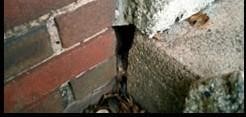There are times when spring cleaning can be dangerous…
By Marcia Anderson
I live in a suburban area, surrounded by woods, lots of woods. So an occasional visit by an insect or rodent is inevitable.
Field mice drop in for the winter, especially when my family unintentionally invites them by leaving the garage or deck doors open. The mice also slip into the basement through the gap between the door and the floor we keep meaning to seal. Even though the gap is small, they still manage to squeeze through. Mice can squeeze through a hole the size of a dime, and rats can squeeze through a hole the size of a quarter! Once inside the little critters seek food, water and a warm shelter.
During the winter months the little pests usually go unnoticed. However, every spring or summer when I clean sections of my basement, I find mouse droppings, patches of urine, nesting material and occasionally a dried corpse. The same scene also plays out as warm weather motivates us to clean out our backyard shed and open our little vacation cabin in the woods.
More than just a spring nuisance, cleaning up after rodents in and around your own home, cabin, shed or barn can put you at risk from the allergens and illnesses that go hand-in-hand with rodents. Rodent droppings can be prime allergy or asthma triggers in urban or rural settings. Even worse, Hantavirus Pulmonary Syndrome a severe and sometimes fatal disease caused by the hantavirus, is spread by rodents. The American Lung Association provides helpful information on rodent-borne illnesses, including hantavirus.
Rodents throughout most of North America carry forms of hantavirus, deer mice in the west, cotton rats in the southeast, and white-footed mice in the northeast. The Centers for Disease Control reports that Hantavirus Pulmonary Syndrome has occurred in 34 states. The disease is spread through either direct contact with rodent urine, droppings and saliva, or by breathing in dust that is contaminated with rodent urine or feces.
There are things that you can do to both prevent rodent problems and to safely clean up if you find them indoors. Focus on prevention – remove the food sources, water, and entry points into your home or other shelter. This is the cornerstone of Integrated Pest Management (IPM), a smart, sensible and sustainable way to reduce pests, including mice and rats.
Keep pests out by sealing gaps or holes outside your home, garage or outbuilding. Look for holes in the roof near the roof among the rafters, gables, eaves, windows, attic vents and crawl space vents. Check for holes around the foundation and where electrical, plumbing, cable, and gas lines enter. When you find small holes, pack them with steel wool then apply a sealant to keep it in place.
To fix larger holes, use lath screen, lath metal, hardware cloth, metal sheeting or cement to repair. Install a door sweep to close off gaps under doors. As long as these entry points remain open, rodents will continue to get inside.
Other steps you should take on your property are aimed at eliminating outdoor nesting sites. Position compost bins and woodpiles at least 100 feet from buildings. Elevate garbage cans and, if possible, woodpiles at least one foot off the ground. Get rid of old tires, cars, and trucks that mice and rats could use as homes. Keep grass cut short and shrubbery trimmed away from buildings. Keep bird feeders away from the house and use squirrel guards to limit squirrels and other rodent access.
Remember a few key points to keep food away from any rodents that do make it indoors. Store your non-refrigerated food in thick plastic, glass or metal containers with tight lids. This includes pet food, grains and domestic animal feed. Uneaten animal feed should be returned to its storage container or disposed of each evening. Wash and dry dirty dishes and make sure there are lids on your trash cans.
If you have a building with signs of rodent activity inside, take care when cleaning to avoid potentially serious health consequences. Avoid actions that raise contaminated dust, such as sweeping or vacuuming rodent feces. Instead, follow the Centers for Disease Control and Prevention recommendations for cleaning up after rodents that include wearing gloves when cleaning and properly disinfecting.
About the Author: Marcia is with EPA’s Center of Expertise for School IPM in Dallas, Texas. She holds a PhD in Environmental Management from Montclair State University along with degrees in Biology, Environmental Design, Landscape Architecture, and Instruction and Curriculum. Marcia was formerly with the EPA Region 2 Pesticides Program and has been a professor of Earth and Environmental Studies, Geology, and Oceanography at several universities.



